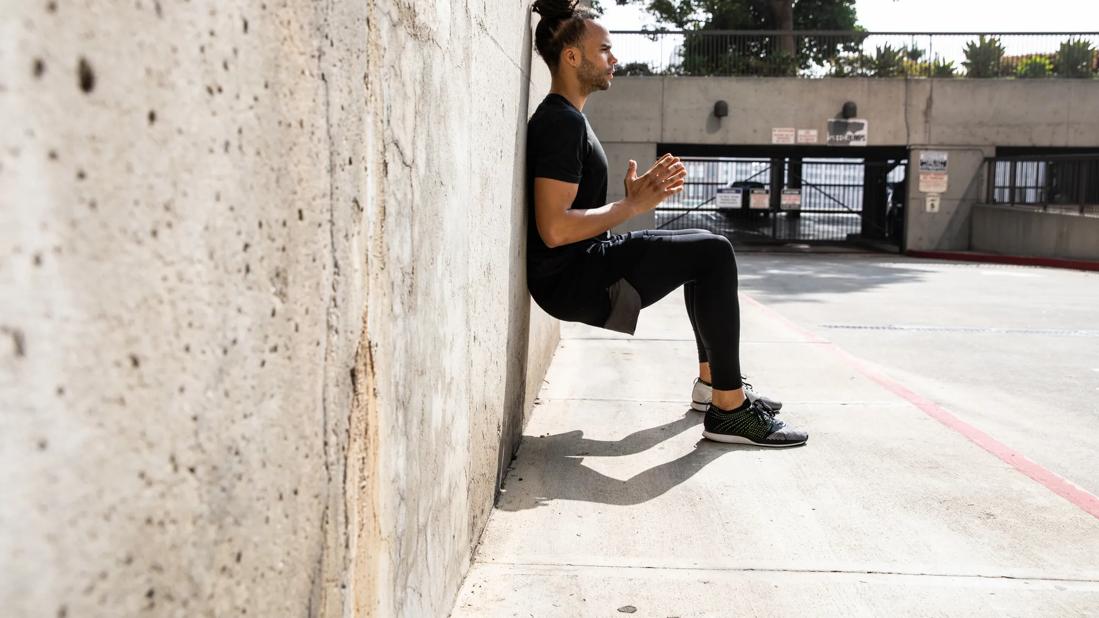Wall sits can burn fat, strengthen your core, improve posture and even lower blood pressure

Sitting isn’t a workout — or is it?
Advertisement
Cleveland Clinic is a non-profit academic medical center. Advertising on our site helps support our mission. We do not endorse non-Cleveland Clinic products or services. Policy
If you’re doing wall sits, it definitely is! Why is this seemingly simple exercise so beneficial, and how do you do it?
Physical therapist Rebecca Justen, DPT, has the answers.
Wall sits (or wall squats) are an isometric exercise, which is an exercise where you hold a particular position without moving.
“Isometric exercises work your muscles by making you hold them steady, rather than actively lifting, pulling or pushing,” explains Dr. Justen. “As you hold the sit, your muscles have to work against gravity. This resistance helps you build strength and works your range of motion.”
A wall sit looks like a squat (and as the name implies, you’re using the wall as support). But don’t rule them out if squats aren’t your jam.
“The extra support of the wall is helpful for people who can’t do a squat on their own,” she adds. “And wall sits aren’t just for fitness beginners. You can make the exercise more difficult by going deeper or holding it longer.”
To do a wall sit:
Advertisement
On the surface, wall sits can seem pretty basic — after all, you’re just squatting against a wall. But as soon as you get into position, you’ll start to feel the burn in your quadriceps, hamstrings and glutes.
This exercise has several benefits, including:
Wall sits are great for core strength. A strong core (muscles in your abdomen, pelvis and lower back) supports your spine and may reduce lower back pain.
“When you do wall sits, you use your core muscles to hold yourself steady,” says Dr. Justen. “This position helps you build the muscles in your abs, sides and back.”
Cardio isn’t the only way to slim down. Muscle-building exercises can help rev up your metabolism so you burn more body fat.
“The more muscle you have, the more calories you burn, even at rest,” she explains.
Don’t have exercise bands, weights or other fitness equipment? No problem.
“All you need is your body and a stable wall,” Dr. Justen states. “You can do wall sits any time of day, like during a work break.”
“You can do wall sits regardless of your ability if you start by going down just a few inches,” she notes. “As you gain strength, you can go deeper into your sit to make it more challenging. There’s a level of wall sit that’s right for nearly everyone.”
If you slouch during the day (who doesn’t?), wall sits can help you focus on your posture.
“Wall sits are like a reset for the muscles that become weak from improper posture,” Dr. Justen says. “Pushing your back against the wall engages the muscles that help straighten your spine.”
High blood pressure is a leading cause of heart disease, and studies show that wall sits may help combat it.
“Any physical activity can improve blood pressure, and isometric exercises are no exception,” she reinforces. “In fact, research shows that a regular isometric program can lower blood pressure more than other types of exercise.”
Your quadriceps, the muscles in the front of your thighs, spring into action during a wall sit.
“Your quads are important for everyday life, such as when you get up from a chair or climb a flight of stairs,” outlines Dr. Justen. “Strong quads also help absorb shock when you walk, run and jump.”
Trouble with balance is a leading cause of falls. Wall sits could help combat this issue.
“Isometric exercises improve communication between your muscles and brain, which improves your physical coordination,” explains Dr. Justen. “Better coordination leads to better balance, which can help you avoid falls.”
Advertisement
If your knees are sore, stiff or weak, wall sits could help.
“Wall sits strengthen your quads and hamstring muscles,” she says. “These muscles support your knees, which could help improve knee pain.”
Trying a new exercise can feel intimidating, especially if it involves strength training. But the beauty of wall sits is that you can do what works for you.
“If you can stand and walk independently, you can probably do a wall sit,” encourages Dr. Justen. “And whether you can hold it for five seconds or 60 seconds, you’ll get benefits from it. Exercise is about challenging yourself, no matter where you’re in your fitness journey.”
Advertisement
Learn more about our editorial process.
Advertisement

Lower-intensity workouts can deliver high-quality health and fitness results

Incremental changes in your exercise routine can improve your strength and endurance over time

Understanding heart rate zones can help you tailor your workout to reach your goals

Increase the size of your muscles by bulking up on protein and focusing on slow, intense movements with progressive overloading

Low-impact exercises help you recover faster between sets, during cool downs and on rest days

Eccentric is slow and steady, while concentric is fast and controlled

Weightlifting can help you build muscle mass, reduce joint pain and increase flexibility to improve your quality of life

Abdominal exercises don’t have to be done on the floor!

Babies can get congested easily, but you can calm their cough by keeping them hydrated, using nasal drops and running a humidifier

Weight loss may cause loose, sagging skin and muscle loss to your rear

Several conditions, like vitiligo and fungal infection, can cause a loss of pigmentation, leading to white spots or patches on your skin